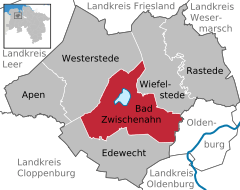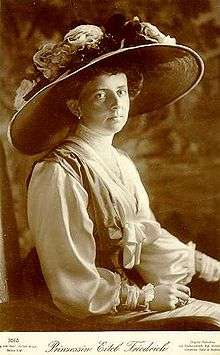Bad Zwischenahn
| Bad Zwischenahn | ||
|---|---|---|
| ||
 Bad Zwischenahn Location of Bad Zwischenahn within Ammerland district   | ||
| Coordinates: 53°11′01″N 08°00′35″E / 53.18361°N 8.00972°ECoordinates: 53°11′01″N 08°00′35″E / 53.18361°N 8.00972°E | ||
| Country | Germany | |
| State | Lower Saxony | |
| District | Ammerland | |
| Government | ||
| • Mayor | Dr. Arno Schilling (SPD) | |
| Area | ||
| • Total | 130 km2 (50 sq mi) | |
| Elevation | 7 m (23 ft) | |
| Population (2017-12-31)[1] | ||
| • Total | 28,507 | |
| • Density | 220/km2 (570/sq mi) | |
| Time zone | CET/CEST (UTC+1/+2) | |
| Postal codes | 26160 | |
| Dialling codes | 04403 | |
| Vehicle registration | WST | |
| Website | www.bad-zwischenahn.de | |
Bad Zwischenahn (Low German: Twüschenahn) is a town and a municipality in the low-lying Ammerland district, in Lower Saxony, Germany. It is situated on the lake Zwischenahner Meer, approx. 15 km northwest of Oldenburg, and about 70 km south of the North Sea coast.
History
During World War II it was the home base of the largest Luftwaffe airbase in northern Germany, with first the Erprobungskommando 16 service-test unit, then Jagdgeschwader 400 each in their turn operating the Messerschmitt Me 163 Komet rocket fighter from the base, which was heavily bombed. Following the War, the airbase was converted to a golf course.
Economy
The main economic activities of Bad Zwischenahn were and are based on tree nurseries, the food industry (sausage and ham production), and resort community services for the well to do urban population of Oldenburg and Bremen. The lake is used for boating, bathing and recreation, with some eel fishing still undertaken.
One of the premier sites for tourists is a windmill originally built in 1811 in Westerstede. It is part of a historical museum farm consisting of 14 houses and auxiliary buildings that were moved to their today's location from 1909 to 2004.[2] One of the buildings is called the Spieker and shelters a restaurant of the same name, integrating into the centuries-old architecture.
A major source of money is the tourism industry. There is Bad Zwischenahn above average number of apartments from private providers. These homes often have a higher standard and are awarded with 3 stars or more.[3] The spa facilities are the reason why older people often come to Zwischenahn.
Transportation
Bad Zwischenahn railway station has services to Leer and Oldenburg.
The Zwischenahner Meer has regular ferry routes from Zwischenahn to Dreibergen and Rostrup.
Local traditions
Locally smoked eels are a delicacy, particularly when served with a locally produced schnapps called Ammerländer Löffeltrunk. There is a specific local tradition (also called Ammerländer Löffeltrunk) to drink it from a tin spoon along with a special drinking cheer, each line alternately spoken by the host and the guests:
| Original (Low German) | German translation | English translation |
|---|---|---|
| Ik she Di! | Ich sehe Dich! | I see you! |
| Dat freit mi! | Das freut mich! | That makes me glad! |
| Ik sup Di to! | Ich trinke Dir zu! | I drink to you! |
| Dat do! | Tu das! | Do that! |
| Prost! | Prost! | Cheers! |
| Ik heb Di tosopen! | Ich habe Dir zugetrunken! | I've drunk to you! |
| Hest den Rechten dropen! | Du hast den Richtigen getroffen! | You met the right one! |
| So hebt wi dat immer doh'n! | So haben wir das immer getan! | That's how we always did! |
| So schall dat ok wieter goh'n! | So soll das auch weiter gehen! | That's how it shall go on! |
Beside drinking, the Ammerländer Löffeltrunk is also used to clean one's hands after eating the smoked eel.
Personalities
Sons and daughters of the community
- Wilhelm Heinrich Schüßler (1821-1898), founder of the "Biochemische Heilweise", the therapy with so-called Schüßler salts
- Carsten Linke (born 1965), former footballer of Hannover 96
Connected to Bad Zwischenahn

- Gerhard VI, Count of Oldenburg (1430-1500), sea and street robber, regent of Bad Zwischenahn
- Richard Friese (1854-1918), major German animal painter and sculptor, died in Bad Zwischenahn
- Johann Friedrich Höger, named Fritz Höger (1877-1949), architect, built the water tower in Bad Zwischenahn in 1928
- Sophie Charlotte von Oldenburg (1879-1964), lived from 1951 until her death in a small house in Bad Zwischenahn.
- Horst Eckert (born 1931), known as Janosch, author and painter, lived from 1946 to 1952 and then again from 1953 to 1958 in Bad Zwischenahn
- Udo Pastörs (born 1952), politician of the NPD has grown up here.
References
External links

